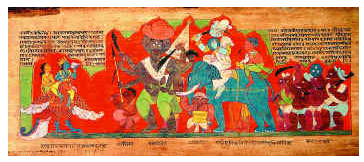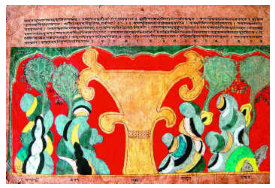The Bhakti Cult that rose to prominence during the time of Sankaradeva spearheaded the resurgence of art and culture veering around devotion and worship in Assam. Religious scriptures were venerated and they became subjects of painting, dance, music and architecture. Community prayer gained prominence in lieu of individual worship. The Bhagavatha Purana rendered into Assamese by Mahapurush Sankara deva made it accessible to the local populace. These Assamese verses were painted on cloth and came to be known as manuscript paintings.

The illustration and transcription of religious manuscripts by tribes like Likhaks, Patuas and Khanikars gradually evolved into the Assam school of painting. The Assam School of painting was divided into Sattriya and Royal styles.
The Sattriya styles contained the stories of the Epics and Puranas and were illustrated under the guidance of the Vaishnava preachers like Shankaradeva and Madhavadeva. Different combinations of colours were used and they characterised dramatic narration, simple composition and precise draughtsmanship. The manuscripts or Sanchipats are made from the bark of the aloe or Sanchi tree through a complex, intricate and lengthy procedure. This method which is unique to Assam is said to have been later used by the Greeks when Alexander invaded Punjab and he also discovered the Indian tradition of using well-beaten cotton cloth and the inner bark of trees as writing materials. These traditional paintings dated back from the 7th century AD and the most prominent ones were Hastividyaranya and Chitra Bhagavata.

The paintings of the Patuas were called Pats. The works of the Khanikars centred on monasteries or Satras and the Naam Ghars and were excellent artistic creations. Most of these paintings were found in the manuscripts including paintings done on Assam silk. This style of paintings also showed the influence of Mughal, Pahari and Rajput styles along with local traditional Assam traditions. The Royal style developed two more styles Darrang and Garhagaon.
